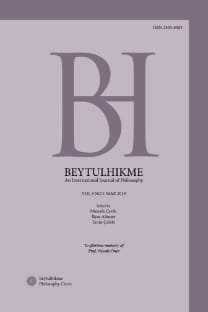Heidegger's Conception of Poetic Dwelling through Appropriation of History
Heidegger's Conception of Poetic Dwelling through Appropriation of History
This paper explores the significance of poetic dwelling in Martin Heidegger’s later thought in terms of its relevance to the essence of truth and his notion of the fourfold as world’s disclosure. Heidegger emphasizes that the poetic provides us with a better understanding of our modern era, which is notable by the oblivion of Being. He regards history as a homecoming, which manifests itself when we remember that we are in a dialogue with the destining of Being. After clarifying the relationship between poetic dwelling and appropriation of history whilst referring to Friedrich Hölderlin’s hymn, “The Ister” (“Der Ister”), this paper argues that according to Heidegger, the precondition of participating in history is learning to listen and respond to the address of Being; which is only possible via the poetic which enables us to feel home and genuinely dwell on this earth
___
- Bernasconi, R. (1985). The Question of Language in Heidegger’s History of Being. USA:Humanities Press International.
- Biemel, W. (1980). Poetry and Language in Heidegger. On Heidegger and Language.
- (Ed. and trans. Joseph J. Kockelmans). Evanston: Northwestern University Press, pp. 65-106.
- Heidegger, M. (1968). What is Called Thinking? (Trans. J. Glenn Gray). New York: Harper & Row Publishers.
- Heidegger, M. (1971a). The Thinker As Poet. Poetry, Language, Thought. (Trans. Albert Hofstadter). New York: Harper & Row Publishers, pp. 1-14.
- Heidegger, M. (1971b). Building, Dwelling, Thinking. Poetry, Language, Thought. (Trans. Albert Hofstadter). New York: Harper & Row Publishers, pp. 141- 160. Heidegger, M. (1971c). ...Poetically Man Dwells… Poetry, Language, Thought. (Trans. Albert Hofstadter). New York: Harper & Row Publishers, pp. 209- 227. Heidegger, M. (1977). The Turning. The Question Concerning Technology and Other Essays. (Trans. William Lovitt). London: Garland Publishing Inc., pp. 36-50.
- Heidegger, M. (1978). On the essence of Truth. Basic Writings: Martin Heidegger. (Ed. David Farrell Krell). London & New York: Routledge, pp. 111-138.
- Heidegger, M. (1991). Overcoming Metaphysics. The Heidegger Controversy: A Critical Reader. (Ed. Richard Wolin). New York: Colombia University Press, pp. 67-90. Heidegger, M. (1996). Hölderlin’s Hymn “The Ister.” (Trans. William McNeill and Julia Davis). Indianapolis: Indiana University Press.
- Heidegger, M. (1998a). What is Metaphysics? Pathmarks. (Ed. William McNeill). Cambridge: Cambridge University Press, pp. 82-96.
- Heidegger, M. (1998b). Postscript to What is Metaphysics. Pathmarks. (Ed. William McNeill). Cambridge: Cambridge University Press, pp. 231-238.
- Heidegger, M. (2008). Hölderlin and the Essence of Poetry. Existence and Being. (Trans. Douglas Scott). Chicago: Henry Regnery Press, pp. 291-316.
- Hölderlin, F. (1966). The Ister. Friedrich Hölderlin: Poems and Fragments. (Trans. Michael Hamburger). London: Routledge, pp. 494-495.
- Hölderlin, F. (1966). In Lovely Blueness. Friedrich Hölderlin: Poems and Fragments. (Trans. Michael Hamburger). London: Routledge, pp. 601-603.
- Marx, W. (1972). The World in Another Beginning: Poetic Dwelling and the Role of the Poet. On Heidegger and Language. (Ed. Joseph J. Kockelmans). Evanston: Northwestern University Press, pp. 235-260.
- Pattison, G. (2000). The Later Heidegger. London: Routledge. Young, J. (2001). Heidegger’s Philosophy of Art. Cambridge: Cambridge University Press.
- Young, J. (2002). Heidegger’s Later Philosophy. Cambridge: Cambridge University Press.
- ISSN: 1303-8303
- Başlangıç: 2011
- Yayıncı: Mustafa Çevik
Sayıdaki Diğer Makaleler
Hanbelî Geleneği Teşbihden Arındırma Girişimi: Ebü’lFerec İbnü’l-Cevzî’nin İtirazları
The Concept of Happiness in the Philosophy of Nasir al-Din al-Tusi
McTaggart on Religion and Metaphysics and King’s Criticisms of These Views
OLENA ALEKSANDROVA, SVITLANA KHYRIPKO, VIKTOR OGNEVIUK, ANDRIY TKACHUK
Heidegger’s Antigone: The Ethos of Poetic Existence
Heidegger's Conception of Poetic Dwelling through Appropriation of History
